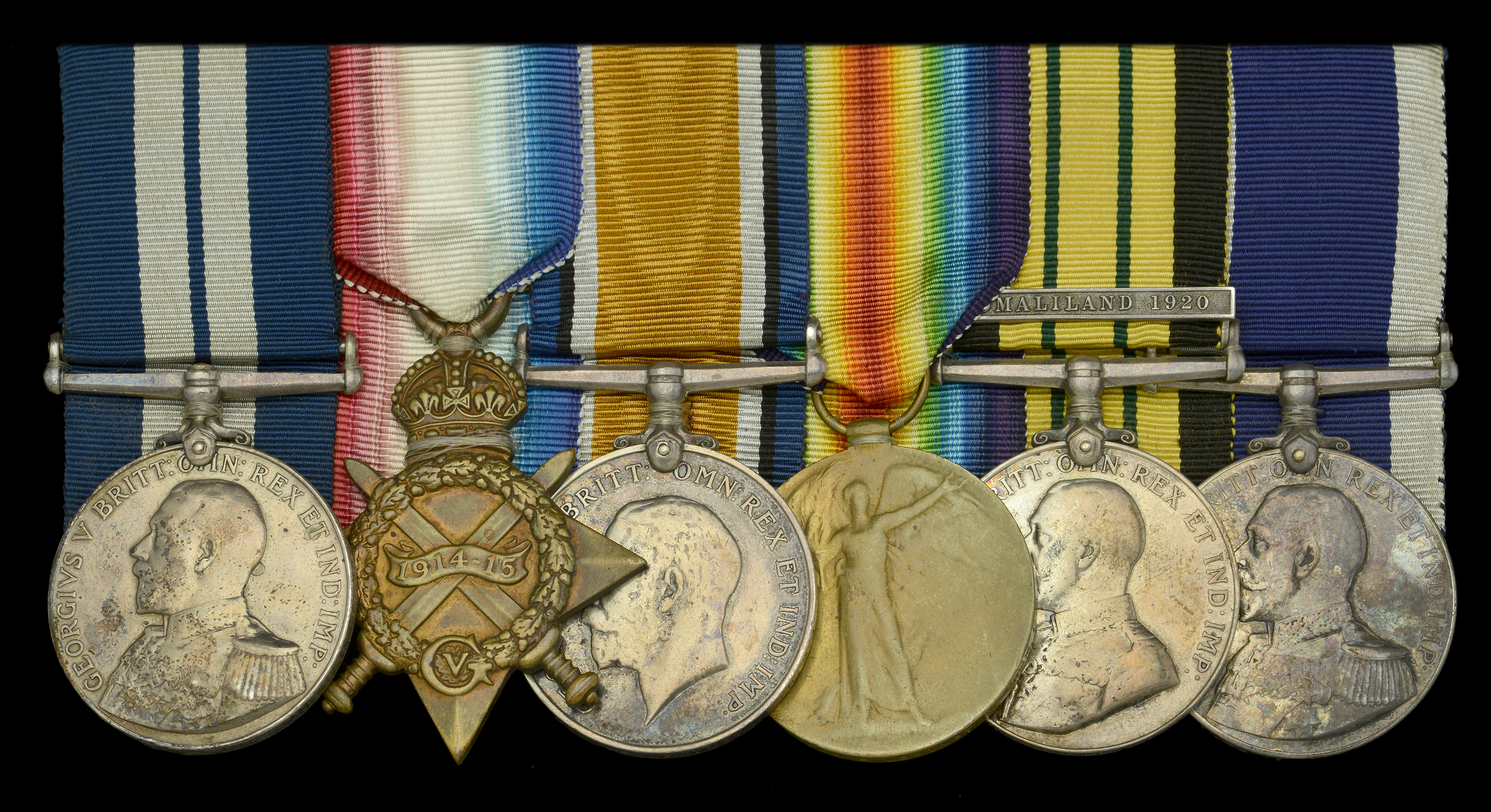A very rare Russian Allied Naval Brigade 1918-19 operations D.S.M. group of six awarded to Corporal W. E. Lewington, Royal Marine Light Infantry Distinguished Service Medal, G.V.R. (PO/16216. Pte. W. E. Lewington, R.M.L.I. Russian Allied Nl. Bde. Dec. 1918. Jan. 1919); 1914-15 Star (PO. 16216, Pte. W. E. Lewington, R.M.L.I.); British War and Victory Medals (PO. 16216 Pte. W. E. Lewington. R.M.L.I.); Africa General Service 1902-56, 1 clasp, Somaliland 1920 (PO. 16216 Pte. W. E. Lewington. H.M.S. Odin); Royal Navy L.S. & G.C., G.V.R., 2nd issue, fixed suspension (PO. 16216 W. E. Lewington. Cpl. R.M.) contact marks and polished, thus fine or better (6) £2,000-£3,000 --- Importation Duty This lot is subject to importation duty of 5% on the hammer price unless exported outside the UK --- --- Provenance: Dix Noonan Webb, September 2003. D.S.M. London Gazette 22 April 1919. The recommendation states: ‘Russian Naval Brigade, 1 January 1919. With Acting Sergeant Geary, these two Marines acted as Company Sergeant Majors and showed conspicuous bravery in action and skill and good temper in handling their men’ (ADM 137/1711/322 refers). ‘Recommended for accelerated promotion in the Corps’ (ADM 137/1711/318 refers). A full account of the Royal Marines in Russia may be found in Blumberg’s Britain’s Sea Soldiers 1914-19, a publication that also confirms the recipient’s award as being one of just nine D.S.Ms to the Corps for these operations with the Russian Allied Naval Brigade, but one of only two with this specific inscription and dates. Among several actions the same work describes two sharp encounters with a Bolshevik armoured train near Kem: ‘At 4.30 a.m. next morning [on 3 May 1919] the advance was re-organised, the Russians, who were of little use, being placed in support, the French took the right flank and were eventually lost in the wood, the Royal Marines were in the centre and on the left. After advancing formation for attack was assumed and the [R.M.A.] gun took up position on the right of the railway and opened fire over their heads. The [enemy’s] armoured train came on to about 600 yards firing its machine-guns but was forced to retire and all platoons advanced under rifle and machine-gun fire until within sight of their objective. The forest was very thick on both sides, but the advance was made under cover until the clearing was reached when the force was held up. The enemy could be seen retiring, and a few minutes later a large engine shed was blown up and the troops marched into a place which was a large railway centre called Maselskaya about 11 a.m. on 3 May 1919. Rations were exhausted and they were badly off for food because twenty seven railway bridges had been blown up and supplies could only come up in small lots ... ... About 14 days later the Royal Marines were ordered to advance again, and reached the next siding without meeting any resistance. Later they were reinforced by the K.R.R.C. and together they pushed on until they met the enemy holding a position at No. 12 siding, where the enemy were quickly dislodged, but at the next siding, No. 11, strong resistance was encountered and the company was held up for 14 hours before the position was gained. Food supplies were still scanty and the men became very exhausted and were given 24 hours rest. The next morning the advance was continued under very trying conditions and during the day again met the armoured train, but the force were able to take cover in the forest. The 65mm. gun came into action and the enemy retired and the force arrived within attacking distance of a large village and railway station called Medvyeja Gora on the western edge of Lake Onega. After several hours fighting the Royal Marines alone took this position and held it; the retreating enemy left dynamite in the fireplaces of many of the big buildings and also at the railway station and set the forest on fire ...’ It is interesting to note that due to the intense cold of the Arctic winter, Sir Ernest Shackleton travelled to Murmansk to advise the Force based on his experiences gained in the Antarctic. As a result, each man was issued with an Arctic kit designed by him, comprising four sets of Wolseley underclothing, one Burberry suit, one large woollen lined overcoat, 12 pairs of socks, one pair of Shackleton boots, one Arctic cap, special gloves, one pair of blizzard goggles, one pair of skis and sticks, and one Westinghouse rifle manufactured in the U.S.A. The Force was also equipped with small axes, sleighs as used in Sir Ernest’s last expedition, sleeping bags, Stockholm tar and specially prepared food. William Ernest Lewington, who was born at Chilcombe, near Winchester in April 1894 and who enlisted in the Royal Marine Light Infantry at Southampton in January 1912, finally retired in April 1933, stating his intended place of residence as Sussex Street in Winchester. Sold with further career details including some unusual conduct sheet entries, among them ‘skylarking whilst on sentry on the aft deck’ of H.M.S. Prince of Wales in 1913 and ‘shaving upper lip against regulations’ on more than one occasion.





